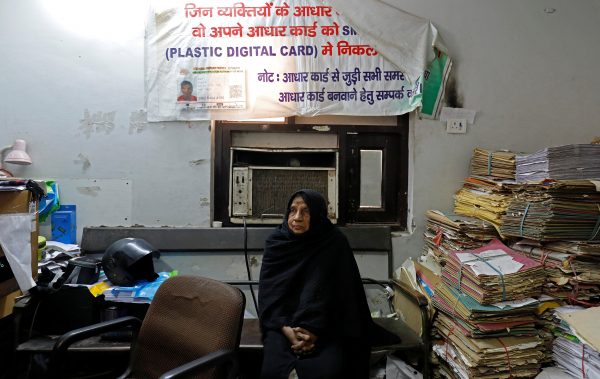Indian lives and livelihoods are suffering inconsolable losses because of the COVID-19 pandemic. While most Indians have suffered a financial setback, many are also suffering socioeconomically, psychologically and generationally. The Indian economy shrank by 7.3 per cent in 2020–21. The unemployment rate increased from 7.46 per cent in August 2019 to 10.4 per cent in April 2020. It later increased to 11.55 per cent in August 2020 and has since moderated to 8.32 per cent in August 2021.
According to a 2021 Azim Premji University report, half of India’s workforce employed in the formal sector was pushed into the informal sector between 2019 and 2020. The poorest 20 per cent of households lost their entire incomes in April and May 2020. Estimates vary considerably, but the pandemic has pushed anywhere between 75 million and 300 hundred million people in India into poverty.
Aadhaar was launched in September 2010 by India’s then prime minister Manmohan Singh. It is a unique digital ID issued to every individual who meets certain conditions and was the first form of ID issued to many Indian residents. Almost the entire adult Indian population has been issued an Aadhaar number. The only demographics with a low uptake of Aadhaar are children below five years of age, people from the states of Assam and Meghalaya and transgender people.
Since March 2020, the government of India has sustained its efforts to support vulnerable people. India’s Public Distribution System (PDS), the largest food-based welfare scheme in the world, expanded during the pandemic. One of the ways this was achieved was through the scaling up of the one-nation-one-ration-card (ONORC) scheme.
ONORC specifically benefits migrant workers. To establish their entitlement under the PDS, each beneficiary usually requires a ration card. Every ration card is attached to a fair price shop (FPS) that sells subsidised grains. But workers who migrate, change their place of dwelling frequently. Because of this movement, migrant workers were being deprived of their entitlement to food grains.
The scaling up of ONORC facilitated migrants accessing their entitlements from any FPS through authentication via Aadhaar. More than 14.7 million transactions were recorded through Aadhaar in May 2021. Back in December 2019, this number was about 8.7 million.
Aadhaar is also facilitating direct cash transfers to identified groups of vulnerable people. One of these groups is women. Any woman who opened an Aadhaar-linked Jan-Dhan savings bank account received an unconditional cash transfer of Rs 500 (US$8) per month for three months. This transfer was made to about 200 million women. Further, the state governments disbursed around Rs 56 billion (US$762 million) to 18.3 million building and construction workers.
Aadhaar has also acted as a mechanism for the second largest vaccination drive in the world, enabling a seamless administration of vaccinations and the real-time generation of vaccination certificates. With the integration of Aadhaar numbers with mobile phone numbers, the government can issue digitally signed vaccination certificates with a unique QR code to each vaccinated person in real-time.
Digital payments are further facilitated by the Reserve Bank of India’s National Payments Corporation of India that allows people to use Aadhaar to transfer money via its Bharat Interface for Money application. To transfer money, an individual can enter the recipient’s Aadhaar number and the money is sent to their Aadhaar-linked bank account. Even though the app existed before the pandemic, it has benefitted many people during lockdowns.
But the government could have used the Aadhaar platform to greater effect. Two missed opportunities are particularly important.
First, if the Aadhaar platform can facilitate the identification of the poorest people in India, governments could better devise a system to provide targeted financial support to the most distressed and vulnerable. Before the introduction of Aadhaar, the beneficiaries of various welfare schemes used multiple identification documents and their data was stored in multiple government databases. There was no way to compare these databases to estimate the benefits drawn by a particular beneficiary from various schemes.
The use of Aadhaar across multiple databases now makes it possible to quantify the total benefits received by an individual under various welfare schemes. The Odisha state government has used multiple databases to identify vulnerable persons in farming communities and provide direct income support to farmers, landless workers, agricultural labourers and other vulnerable agricultural households. The Indian government is yet to leverage this feature of Aadhaar at the national level.
Aadhaar can also help improve the targeting and efficiency of a system. In the case of the Mahatma Gandhi National Rural Employment Guarantee Scheme, Aadhaar has helped shorten the time taken to process the payment of wages. But there are issues with the administrative machinery of the scheme, which delays the transfer of funds to beneficiaries. Such gaps in the system need to be amended so that the benefits of Aadhaar can be realised.
The Aadhaar platform has demonstrated many benefits during the COVID-19 pandemic. It is time the Indian government more effectively leverages Aadhaar and makes the most of its real potential.
Shweta Saini and Siraj Hussain are Visiting Senior Fellows at the Indian Council for Research on International Economic Relations.

